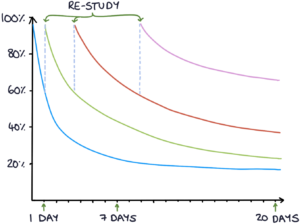The spacing effect is a well-recognised psychological phenomenon. It is an incredibly powerful tool that you can use to boost the quality and length of your memory. It was first introduced by a psychologist called Ebbinghaus in 1885, who noted a benefit from spacing study sessions as opposed to doing those all in one go. Psychological studies have repeatedly shown that spacing study sessions over a longer period of time produce more solid and lasting memories than repeated study in a shorter space of time.
A practical (and slightly exaggerated) example of this is two students who want to learn how to interpret lung function tests. Both students read about lung function tests. They understand them and explain them to a friend who is struggling to understand them. Their understanding and knowledge is good that day.
Student A decides that she wants to make sure she really remembers the information and studies lung function tests the next day and the day after. She has studied them a total of 3 times and feels really confident about the topic.
- DAY 1: Revise lung function
- 1 DAY LATER: Revise lung function
- 1 DAY LATER: Revise lung function
- 2 MONTHS LATER: Exam
The trouble is that memory gradually falls over time, and two months later when she sits her exam, she struggles to remember how they worked.
Student B decides to move on and learn something else. She returns to lung function tests several weeks later and realises she has lost much of what she learned. She studies them again and feels confident about the topic again. She repeats this a month or so later. She has also studied them a total of 3 times.
-
- DAY 1: Revise lung function
- 3 WEEKS LATER: Revise lung function
- 1 MONTH LATER: Revise lung function
- 2 MONTHS LATER: Exam
Unlike Student A, when her exam rolls around two months later, she is surprised to find she can remember a great deal about lung function tests and comfortably answers the exam questions.
The way I recommend you use this technique is simple. Keep a tracking table of when you study each topic. Once you get your head around a subject and have learned a bulk of it, then move on. Don’t try to study it again the same day or the day after.
After studying a few more topics, come back to the original topic and learn it again. If you haven’t left it too long, when you come back to it, you will find that you remember quite a bit but have forgotten a few details. Recap all the major points, and try to relearn the details you have forgotten. Then move on again.
After a few more topics have been learned and more time has passed, come back to it and recap again. Repeat this process, each time increasing the gaps between study sessions.
Your memory will fall over time, but the spacing effect will help to make your repetition and studying more effective. Your tracking table will tell you how long it has been since you last studied each topic, so you can easily keep track of your progress and repetitions.

